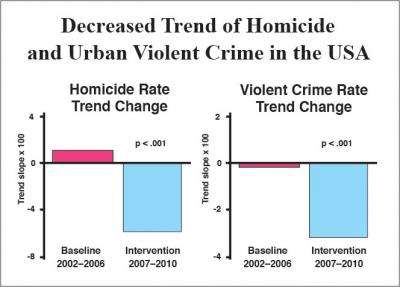Large groups practicing the advanced Transcendental Meditation program were associated with significant reductions in U.S. homicide and urban violent crime rates during an intervention period of 2007-2010.
Can large-group meditation lower the crime rate? The most recent in a series of studies spanning decades suggests that a sufficiently large group practicing an advanced program of Transcendental Meditation, called the TM-Sidhi program, is associated with decreased violence.

For the period 2007-2010, when there was a sufficiently large group, statistical analysis found a significant decrease in both the national homicide rate and urban violent crime rate compared to trends during the baseline period of 2002-2006.
The total drop in the homicide rate relative to the baseline average rate was 21.2% over the four-year intervention period (5.3% per year). Analysis of monthly data showed that a rising trend of U.S. homicides during the baseline period 2002-2006 was reversed during the intervention period 2007-2010 of the study (see graph). Researchers estimate that 8,157 homicides were averted by the highly significant shift from an increasing to a decreasing trend in homicide rates.
The drop in the violent crime rate was 18.5% (4.6% per year). The study found a highly significant shift from a flat trend in 2002-2006 to a declining trend in 2007-2010 for a sample of 206 urban areas nationwide with a population over 100,000 (see graph).
Predicted in advance
Starting in July 2006, advanced meditators assembled at Maharishi International University in Fairfield, Iowa, to create a group large enough to have this influence on the U.S. as a whole.
Predictions were lodged with the press and other scientists that significant decreases in violent crime would occur when the group reached or exceeded the theoretically predicted threshold of the square root of 1% of the U.S. population. By January 2007 the group exceeded the required size of 1,725 participants, the square root of 1% of the U.S. population at the time, and remained above or near that level through 2010.
The study, “Societal Violence and Collective Consciousness: Reduction of U.S. Homicide and Urban Violent Crime Rates,” was published in SAGE Open Apr 2016, 6 (2).

A new hypothesis in the social sciences
“I understand it’s a new hypothesis in the social sciences that meditation could have a stress-reducing and coherence-creating effect in society,” said lead author Michael Dillbeck. “But such research is increasingly suggesting that there’s a field effect of consciousness. If you get a large enough group together practicing this technique to experience the field quality of consciousness, these extended ‘field-like’ effects are expressed in society.”
The hypothesis of a field effect of consciousness implies that there is an underlying connection between individuals in much the same way that physics has uncovered greater unity beneath the diversity of matter and energy fields. The more powerfully that underlying field is enlivened, the greater the unifying influence of peace and harmony on the surface levels of life.
The hypothesis — also known as Maharishi Effect — was first proposed in 1960 by Maharishi Mahesh Yogi, who introduced the Transcendental Meditation technique. This hypothesis was first confirmed by published research in the 1970s and 1980s when it was observed that those cities that had 1% of the population practicing Transcendental Meditation showed significant increases in positive trends.
The Maharishi Effect was even greater when the advanced TM-Sidhi program was introduced, with observations suggesting that just the square root of 1% of a population could increase harmony and improve diverse measures of the quality of life in society.
Nine peer-reviewed articles, comprising 14 studies, have now been published that support this hypothesized effect.
While the earlier studies were based on groups doing their advanced meditation programs for periods of several weeks or months, this current study was for several years, giving researchers an opportunity to study potential long-term changes.

Note. In panel (a), the plot of HOM for Nov. 2002 to Dec. 2010 displays strong monthly seasonality, a relatively flat pre-intervention trend, and a shift to a declining trend in the intervention period starting January 2007 (shown by the vertical line in the plot). Panel (b) shows the plot of the monthly average daily size of the TM-Sidhi group. The group size rose rapidly beginning in July 2006 until in January 2007 it rose for the first time above the theoretically predicted critical threshold of 1,725, √1% of the U.S. population. The average size of the group is 587 participants for the 50 pre-intervention months and 1,792 for the 48 months of the intervention period. HOM = homicide rate. GROUP = size of the group of TM-Sidhi program participants.
Rigorous statistical analysis
The study’s authors used a battery of diagnostic tests to establish the validity of the key statistical assumptions of the analysis, which used “broken-trend intervention analysis” of outcomes, a form of “interrupted time series analysis.”
They also found that alternative hypotheses, such as economic trends, incarceration rates, seasonal cycles, demographic changes, and policing strategies, weren’t sufficient to explain the observed reduction.
For example, violent crime rates fell significantly during the severe recession of 2007-2009 rather than rising as widely expected. According to a leading expert on crime and the economy, this was the first time since World War II in crime rates failed to rise during a major economic downturn.
Important implications for crime prevention
“Given that there are now multiple studies showing a highly significant relationship between a large group practicing the Transcendental Meditation and TM-Sidhi programs and decreased violence in society, this obviously has implications for crime prevention,” Dr. Dillbeck said.
The group that gathered in the period 2007-2010 has now dispersed. Dr. Dillbeck suggests that if governments were to support the establishment of groups in various countries so that these groups could be maintained over long periods, it could have a remarkable effect in reducing hostilities and fostering coherence among nations, which could be assessed by further research.
READ MORE
NBC News: “Jobless rate up, but crime down: What gives?” (Jan 3, 2012)
The New York Times: “Steady Decline in Major Crime Baffles Experts” (May 23, 2011).
The Washington Post: “Violent crime in U.S. on the decline” (May 25, 2010)


















